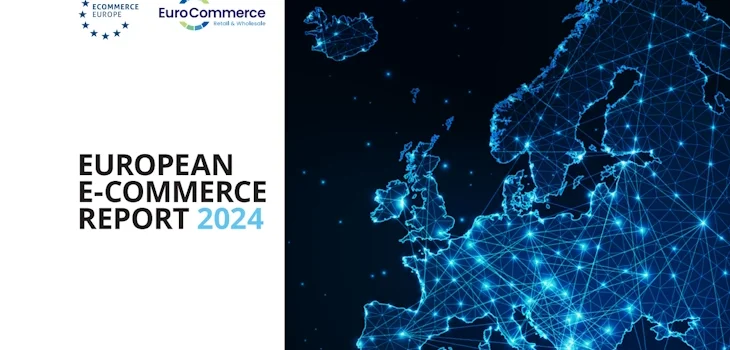
Ecommerce Europe – Press relase 10 october 2024
Ecommerce Europe and EuroCommerce have once again joined forces for the 2024 European Ecommerce Report. In 2023, the European B2C e-commerce sector experienced a modest growth of 3%, up from 2% in 2022, with nominal turnover increasing from €864 billion to €887 billion, and inflation declining from 8.5% to 6.1%. However, despite overall nominal growth, the e-commerce landscape shows significant regional disparities.
The European digital commerce sector is still grappling with challenges slowing its growth since 2022. These include inflation, uneven technological advancement, adopting more sustainable models and adapting to new sustainability regulations. Additionally, EU-based companies are contending with harsh competition from non-EU based players coupled with a lack of fair enforcement of EU regulations on these.
The report’s regional breakdown reveals a mixed performance across different macro-areas. Western Europe, traditionally the largest market for European B2C e-commerce, saw a slight decline of 1%, closing 2023 at €596 billion. In contrast, Southern Europe and Eastern Europe showed strong growth rates of 14% and 15%, respectively, with turnovers reaching €166 billion and €17 billion. Central Europe demonstrated resilience with an 8% increase, totalling €79 billion, while Northern Europe faced a 5% decline, ending at €56 billion.
As in the 2023 edition, the 2024 report includes inflation-adjusted numbers for Europe and its regions. Whilst inflation led to a real decline in e-commerce turnover (-3% adjustment), the comparison between last year’s overall figures and today’s data suggests that inflation is gradually stabilising, with the projected inflation rate for 2024 declining further to a more normal 2.7%. Forecasts also indicate a more robust growth of 8% for 2024, reflecting a rebound in consumer confidence and spending across Europe.
The report highlights the efforts of European e-commerce businesses to comply with new legislation while pursuing growth opportunities. For example, companies are struggling with interpreting and applying the EU Artificial Intelligence (AI) Act principles to proactively design future-proof new shopping experiences, including after-sales and returns. The industry is also exploring or consolidating re-commerce activities, such as refurbishment and second-hand sales, to meet strong consumer demand and comply with new legislation. Despite a potentially more optimistic market outlook, it is crucial for EU and national policymakers to address the issue of unfair competition from non-EU players, particularly those from Asia.
As a reaction to the figures and trends, Luca Cassetti, Secretary General of Ecommerce Europe, commented: “To stabilise after a raft of bumpy years and continue growing, the digital commerce sector needs clear signals from decision-makers, who must acknowledge the role of e-commerce as a driver of a revived European competitiveness. First and foremost, we must ensure a level playing field and effective enforcement of EU rules towards all e-commerce players active in the EU, no matter where they are based. Secondly, it is paramount that policymakers pursue the objectives of channel-neutrality and easy business compliance when looking at the sector, as laid out in our Manifesto.”
Christel Delberghe, Director General of EuroCommerce, commented: “Our report shows that e-commerce remains vibrant and holds significant opportunities for growth through technological advancements and strong consumer demand for sustainability. It also faces many challenges arising from e.g., global competition, different levels of technological adoption or grappling with new EU legislation. The ability of businesses to innovate and adapt to these changing conditions will be key for their success in this competitive landscape, as well as the fair enforcement of EU legislation on all companies selling to EU consumers by European authorities.”
A light version of the report is available here.
An executive summary of the report is available here.

